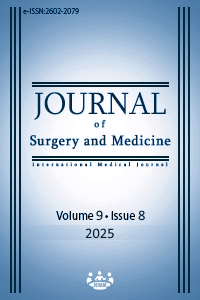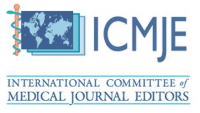Effects of non-pharmacological approaches on anxiety, agitation and physiologic parameters in weaning from mechanical ventilation: A systematic review
Non-pharmacological approaches on weaning from MV
Keywords:
Ventilator Weaning, Music Therapy, Reflexology, Nature, SoundAbstract
Background/Aim: Mechanical ventilator weaning refers to the incremental reduction of ventilatory support, facilitating a return to spontaneous breathing. It is essential that this process be carried out by skilled healthcare professionals equipped with both expertise and sound judgment to ensure it is performed at the optimal time and with the most appropriate methodologies. Such diligence is crucial in mitigating the morbidity and mortality associated with the protraction of mechanical ventilation (MV). The extant literature has explored the efficacy of various integrative, non-pharmacological interventions—including music therapy, guided imagery, reflexology, and aromatherapy—in managing the symptomatic burden experienced during both MV and its weaning phase. This study aims to systematically review the findings of investigations that assess the impact of these complementary therapeutic modalities employed by nurses on anxiety, agitation, and the physiological parameters of patients undergoing weaning from mechanical ventilation.
Methods: PubMed, CINAHL, Cochrane Library, Scopus, and Google Scholar databases were systematically searched using the key terms ‘Mechanical ventilator weaning and complementary therapy or non-pharmacological approaches’ and ‘Mechanical ventilator weaning and/or music therapy, reflexology.’ The search strategy was formulated based on the Patient-Intervention-Comparison-Outcome (PICO) framework: P—Adult intensive care patient cohort; I—Application of non-pharmacological approaches in the context of weaning from mechanical ventilation; C—Standard routine care; O—Outcomes related to anxiety, agitation, and physiological parameters. The 10 most pertinent studies, meeting predefined inclusion and exclusion criteria, were selected, encompassing a total of 750 participants. The predominant study design was the randomized controlled trial (RCT). The interventions examined across these studies primarily involved music and reflexology therapies.
Results: Most of the studies reviewed that the use of non-pharmacological interventions reduces patients’ symptoms such as anxiety, agitation, and pain in patients. These methods also contribute to the stabilization of physiological parameters within normal ranges. Moreover, reflexology has been shown to expedite the weaning process from mechanical ventilation, thereby reducing the risk of prolonged mechanical ventilation, a significant challenge for patients and healthcare professionals.
Conclusion: Complementary therapy used in the process of mechanical ventilator weaning is an appropriate intervention to be used to manage patients’ symptoms such as anxiety, agitation, and pain.
Downloads
References
Güner CK, Kutlutürkan S. Mechanical Ventilation Weaning Methods and the Role of the Nurse. Acıbadem University Journal of Health Sciences. 2020;(3):380-3.
Hetland B, Heusinkvelt J, Krabbenhoft L, Grotts E. Mechanical ventilation weaning: An evidence-based review. Nursing 2020 Critical Care. 2018;13(6):5-16. DOI: https://doi.org/10.1097/01.CCN.0000544397.74806.9a
Mehta AB, Syeda SN, Wiener RS, Walkey AJ. Epidemiological trends in invasive mechanical ventilation in the United States: A population-based study. J Crit Care. 2015;30(6):1217-21. DOI: https://doi.org/10.1016/j.jcrc.2015.07.007
Rose L, Blackwood B, Burns SM, Frazier SK, Egerod I. International perspectives on the influence of structure and process of weaning from mechanical ventilation. American Journal of Critical Care. 2011;20(1):e10-e18. DOI: https://doi.org/10.4037/ajcc2011430
Uysal H. Follow-up of the Patient with Invasive Mechanical Ventilation. Turkey Klinikleri Journal of Nursing Sciences, 2011;3(2):89-99.
Rose L, Dainty KN, Jordan J, Blackwood B. Weaning from mechanical ventilation: a scoping review of qualitative studies. American Journal of Critical Care. 2014;23(5):e54-e70. DOI: https://doi.org/10.4037/ajcc2014539
Tracy MF, Chlan L. Non-pharmacological interventions to manage common symptoms in patients receiving mechanical ventilation. Critical Care Nurse. 2011;31(3):19-28. DOI: https://doi.org/10.4037/ccn2011653
Park JY, Park S. Effects of two music therapy methods on agitation and anxiety among patients weaning off mechanical ventilation: a pilot study. Journal of Korean Academy of Fundamentals of Nursing. 2019;26(2):136-43. DOI: https://doi.org/10.7739/jkafn.2019.26.2.136
Blackwood B, Alderdice F, Burns K, Cardwell C, Lavery G, O’Halloran P. Use of weaning protocols for reducing duration of mechanical ventilation in critically ill adult patients: cochrane systematic review and meta-analysis. BMJ. 2011;342:c7237. DOI: https://doi.org/10.1136/bmj.c7237
Irajpour A, Khodaee M, Yazdannik A, Abbasi S. Developing a Readiness Assessment Tool for Weaning Patients Under Mechanical Ventilation. Iran J Nurs Midwifery Res. 2014;19:273–8.
Hunter BC, Oliva R, Sahler OJZ, Gaisser DA, Salipante DM, Arezina CH. Music therapy as an adjunctive treatment in the management of stress for patients being weaned from mechanical ventilation. Journal of Music Therapy. 2010;47(3):198-219. DOI: https://doi.org/10.1093/jmt/47.3.198
Aghaie B, Rejeh N, Heravi-Karimooi M, Ebadi A, Moradian ST, Vaismoradi M, et al. Effect of nature-based sound therapy on agitation and anxiety in coronary artery bypass graft patients during the weaning of mechanical ventilation: A randomised clinical trial. Int J Nurs Stud. 2014;51(4):526-38. DOI: https://doi.org/10.1016/j.ijnurstu.2013.08.003
Hetland B, Lindquist R, Chlan LL. The influence of music during mechanical ventilation and weaning from mechanical ventilation: a review. Heart Lung. 2015;44(5):416-25. DOI: https://doi.org/10.1016/j.hrtlng.2015.06.010
Saadatmand V, Rejeh N, Heravi-Karimooi M, Davood Tadrisi S, Zayeri F, Vaismoradi M, et al. Effect of nature-based sounds’ intervention on agitation, anxiety, and stress in patients under mechanical ventilator support: a randomized controlled trial. Int J Nurs Stud. 2013;50(7):895e904. DOI: https://doi.org/10.1016/j.ijnurstu.2012.11.018
Kurt T, Celik S. The effect of nature-based sound therapy on the process of weaning intensive care patients from mechanical ventilation. Cukurova Medical Journal. 2019;44:119-32. DOI: https://doi.org/10.17826/cumj.556065
Hetland B, Lindquist R, Weinert CR, Peden-McAlpine C, Savik K, Chlan L. Predictive associations of music, anxiety, and sedative exposure on mechanical ventilation weaning trials. American Journal of Critical Care. 2017;26(3):210-20. DOI: https://doi.org/10.4037/ajcc2017468
Moher D, Liberati A, Tetzlaff J, Altman DG; PRISMA Group. Preferred reporting items for systematic reviews and meta-analyses: the PRISMA statement. PLoS Med. 2009;6(7):e1000097. DOI: https://doi.org/10.1371/journal.pmed.1000097
Karacam Z. Systematic review methodology: a guide to preparing a systematic review. Journal of Dokuz Eylül University School of Nursing. 2013;6(1):26–33.
Hur G. PRISMA Checklist 2020 Update. Online Turkish Journal of Health Sciences 2021;6(4):603-5. DOI: https://doi.org/10.26453/otjhs.1001606
Nahcivan N., Seçginli S. How are the Methodological Quality of Quantitative Studies Included in Systematic Review? Turkiye Klinikleri Public Health Nursing Special Topics. 2017;3(1):10-9.
Hür G, Zengin H, Karakaya Suzan Ö, Kolukısa T, Eroğlu A, Çınar N. Turkish adaptation of Joanna Briggs Institute (JBI) critical appraisal checklist for randomized controlled trials. Sağlık Bilimlerinde İleri Araştırmalar Dergisi 2022;5(2):112-7. doi: 10.26650/JARHS2022-1100929. DOI: https://doi.org/10.26650/JARHS2022-1100929
Yadak M, Ansari KA, Qutub H, Al-Otaibi H, Al-Omar O, Al-Onizi N, Farooqi FA. The effect of listening to holy Quran recitation on weaning patients receiving mechanical ventilation in the intensive care unit: A Pilot Study. Journal of Religion and Health. 2019;58:64-73. DOI: https://doi.org/10.1007/s10943-017-0500-3
Liang Z, Ren D, Choi J, Happ MB, Hravnak M, Hoffman LA. Music intervention during daily weaning trials- A 6day prospective randomized crossover trial. Complementary therapies in medicine, 2016;29:72-7. DOI: https://doi.org/10.1016/j.ctim.2016.09.003
Ebadi A, Kavei P, Moradian ST, Saeid Y. The effect of foot reflexology on physiologic parameters and mechanical ventilation weaning time in patients undergoing open-heart surgery: A clinical trial study. Complementary Therapies in Clinical Practice. 2015;21(3):188-92. DOI: https://doi.org/10.1016/j.ctcp.2015.07.001
Kandemir D, Oztekin SD. How effective is reflexology on physiological parameters and weaning time from mechanical ventilation in patients undergoing cardiovascular surgery? European Journal of Integrative Medicine. 2019;26:43-9. DOI: https://doi.org/10.1016/j.eujim.2019.01.008
Elsayed AE, Kandeel NA, El-Aziz WW. The effect of foot reflexology on physiological indicators and mechanical ventilation weaning time among open-heart surgery patients. Am J Nurs Res. 2019;7(4):412-9. DOI: https://doi.org/10.12691/ajnr-7-4-2
Allahbakhhsian A, Gholizadeh L, Allahbakhshian M, Sarbakhsh P, Abbaszadeh Y. The effects of foot reflexology on agitation and extubation time in male patients following coronary artery bypass surgery: A randomized controlled clinical trial. Complementary Therapies in Clinical Practice. 2020;40:101201. DOI: https://doi.org/10.1016/j.ctcp.2020.101201
Umbrello M, Sorrenti T, Mistraletti G, Formenti P, Chiumello D, Terzoni S. Music therapy reduces stress and anxiety in critically ill patients: a systematic review of randomized clinical trials. Minerva Anestesiologica, 2019;85(8):886-98. DOI: https://doi.org/10.23736/S0375-9393.19.13526-2
Krirnakriengkrai S, Kumar S, Hughes CM, McDonough SM. An experimental study on the effect of reflexology on the nervous system in healthy adults. Complement Ther Med. 2010;18(6):272. DOI: https://doi.org/10.1016/j.ctim.2010.05.023
Bagheri-Nesami M, Shorofi SA, Zargar N, Sohrabi M, Gholipour-Baradari A, Khalilian, A. The effects of foot reflexology massage on anxiety in patients following coronary artery bypass graft surgery: a randomized controlled trial. Complementary Therapies in Clinical Practice. 2014;20(1):42-7. DOI: https://doi.org/10.1016/j.ctcp.2013.10.006
Korhan EA, Khorshid L, Uyar M. Reflexology: its effects on physiological anxiety signs and sedation needs. Holistic nursing practice. 2014;28(1):6-23. DOI: https://doi.org/10.1097/HNP.0000000000000007
Downloads
- 698 670
Published
Issue
Section
How to Cite
License
Copyright (c) 2025 Kübra Şengör, İkbal Çavdar, Eda Polat
This work is licensed under a Creative Commons Attribution-NonCommercial-NoDerivatives 4.0 International License.
















